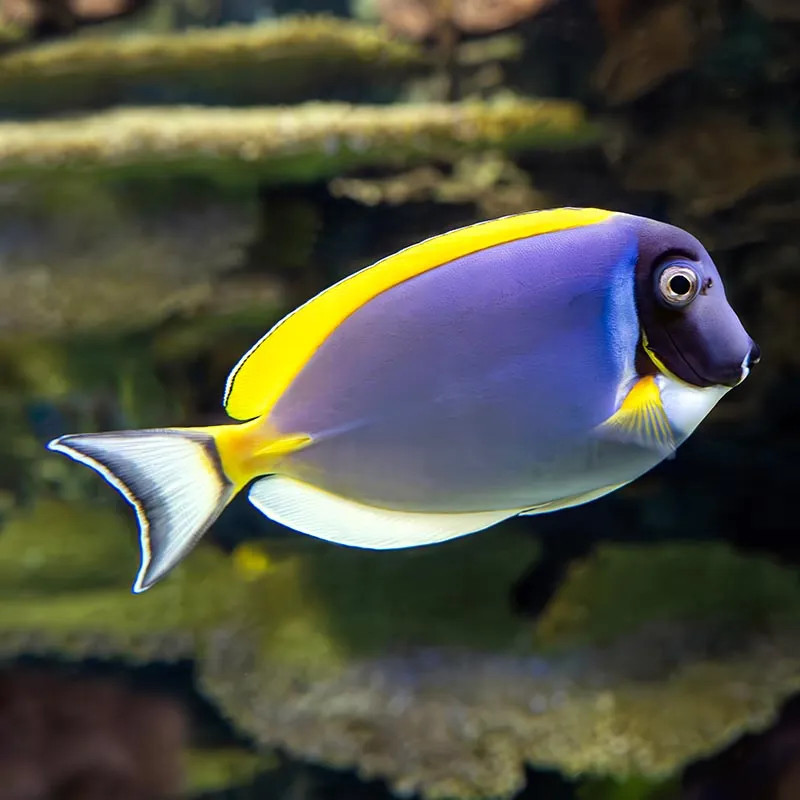Stocks Available
CHOCOLATE SURGEONFISH M
SKU:226151
Acanthurus pyroferus
2-2.75 INCH

Stock Available
Introduction: • Common Name: Powder Blue Tang • Family: Acanthuridae • Native Habitat: This species is predominantly found in the coral reefs of the Indo-Pacific region, including areas around the Red Sea, Hawaiian Islands, and various islands of the Pacific Ocean. Physical Characteristics: • Appearance: The Powder Blue Tang is renowned for its striking coloration. It features a vibrant powder-blue body with a yellow tail and a distinct black spot near its eye. The contrast of colors makes it a favorite among aquarists. • Size: Adults typically reach a length of about 7 to 8 inches (18 to 20 cm). • Body Shape: This fish has a laterally compressed body, characteristic of many surgeonfish, allowing for agile swimming. Habitat Requirements: • Tank Size: A minimum tank size of 100 gallons is recommended to accommodate their active swimming habits. • Water Conditions: o Temperature: Prefers warmer water temperatures between 75°F and 82°F (24°C to 28°C). o pH Level: Ideal pH range is between 8.1 and 8.4. • Aquascaping: Requires plenty of open swimming space along with live rock and coral structures for hiding and grazing. Diet: • Dietary Needs: The Powder Blue Tang is primarily herbivorous, requiring a diet rich in algae and plant matter. Commercial marine algae sheets, spirulina-based foods, and high-quality pellets are suitable options. • Feeding Frequency: Feed multiple times a day in small quantities to mimic natural grazing behaviors. Compatibility: • Temperament: Generally peaceful but can be territorial, particularly towards other tangs or similar-shaped fish. • Suitable Tank Mates: Compatible with various reef-safe species, including clownfish, gobies, and wrasses. • Incompatibilities: Avoid housing with other surgeonfish or aggressive species, as this may lead to conflicts. Care Level: • Difficulty: Considered moderately difficult due to its specific dietary needs and territorial behavior, making it more suitable for experienced aquarists. • Health Monitoring: Regularly check for signs of stress, disease, or parasites, which can affect this species if not properly cared for. Breeding: • Breeding in Captivity: Successful breeding in captivity is rare and challenging. They are known to spawn in the wild, usually during lunar cycles. • Spawning Behavior: In the wild, breeding occurs in pairs or small groups, with eggs being released into the water column, where fertilization occurs. Economic Considerations: • Market Demand: The Powder Blue Tang is highly sought after for home aquariums due to its vibrant appearance. • Wholesale Pricing: Prices can vary based on size, coloration, and availability, but they tend to be on the higher end due to their popularity. • Retail Pricing: Typically found in specialty aquarium stores and online, prices can range widely depending on the source. Sustainability and Conservation: • Wild Population: Overfishing and habitat degradation pose threats to wild populations. It's crucial to support sustainable fishing practices. • Aquaculture: Captive breeding programs can help reduce pressure on wild populations and provide aquarium enthusiasts with healthy specimens. Conclusion: The Powder Blue Tang is a stunning addition to any reef aquarium, known for its vivid coloration and dynamic swimming. With appropriate care, diet, and tank conditions, this species can thrive, providing aquarists with a beautiful and lively aquatic presence.
Data sheet
16 other products in the same category:
Customers who bought this product also bought: